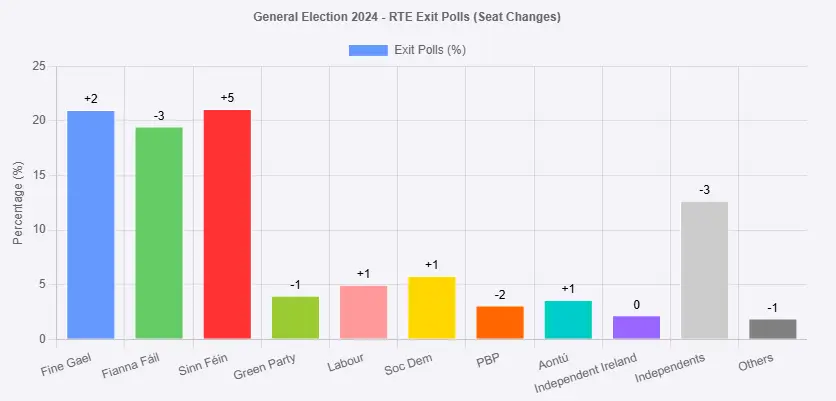
Gains And Loss Expected In The 2024 Irish General Election
|
Getting your Trinity Audio player ready...
|
The General Election 2024 exit poll results have arrived, offering a snapshot of a deeply divided electorate. Sinn Féin leads with 21.1%, followed closely by Fine Gael at 21% and Fianna Fáil at 19.5%. Smaller parties, including the Green Party (4%), Labour (5%), and the Social Democrats (5.8%), retain their modest footholds, while Independents (12.7%) emerge as key players in shaping the next government.
This fragmented outcome reflects Ireland’s evolving political landscape, where no single party dominates. Coalition talks are set to be lengthy and complex, with multiple potential alignments on the table. For predictions before election day, revisit our comprehensive analysis of Election Predictions 2024.
Sinn Féin: A Strong Position but No Clear Mandate
Sinn Féin’s slight edge places them in a position to lead coalition discussions, but with just 21.1% of the vote, they remain well short of the majority required to govern alone. The party’s strong showing is a testament to its focus on housing and social issues, which have resonated with a population grappling with affordability and homelessness crises.
Mary Lou McDonald has already signaled her openness to partnerships with smaller parties, including the Social Democrats and Aontú. However, ideological differences, particularly with the latter, could complicate negotiations. Furthermore, Independents—while vital to securing a majority—may demand significant concessions for regional interests.
Fine Gael: Resilient Despite Long Tenure
Fine Gael’s 21% vote share underscores its resilience after over a decade in power. Under Leo Varadkar’s leadership, the party has framed itself as a stabilizing force amid economic and geopolitical challenges. However, their ability to form a government hinges on securing enough support from smaller parties and Independents.
A coalition involving Fine Gael, the Green Party, and Labour is one possibility, though such an arrangement would require delicate compromises. Fine Gael’s more business-friendly policies might clash with the Greens’ climate agenda and Labour’s focus on workers’ rights, potentially limiting the coalition’s cohesion.
For an external perspective, The Irish Times coverage highlights Fine Gael’s potential strategies and their impact on future governance.
Fianna Fáil: A Steady Decline
Fianna Fáil’s 19.5% performance reflects its continued decline from its dominance of Irish politics in the 20th century. Micheál Martin’s party may still play a crucial role in government formation, potentially rekindling its controversial alliance with Fine Gael.
The Fianna Fáil-Fine Gael coalition, which commanded the last government, might persist to counter Sinn Féin. Together, they hold 40.5% of the vote but will still require support from smaller parties or Independents. However, internal dissent within Fianna Fáil regarding another “grand coalition” could jeopardize such a plan.
Independents: The Kingmakers
Independents, capturing 12.7% of the vote, have emerged as decisive players. Representing diverse constituencies and interests, their role in coalition talks cannot be underestimated. Many are likely to align with whichever party offers the most significant local investment and policy concessions.
Historically, Independents have played pivotal roles in shaping Irish governments, and 2024 is no exception. Their unpredictability adds another layer of complexity to an already challenging negotiation process.
The Role of Smaller Parties
Smaller parties are also set to play outsized roles in government formation:
- The Social Democrats (5.8%): Likely Sinn Féin allies, their focus on progressive policies aligns well with Mary Lou McDonald’s agenda.
- Labour (5%): While diminished, Labour remains a potential partner for Fine Gael or a Sinn Féin-led coalition.
- The Green Party (4%): As staunch advocates of climate action, the Greens may again become a linchpin in government talks. However, their previous coalition with Fine Gael and Fianna Fáil has drawn criticism from their base.
- Aontú (3.6%): The party’s conservative stance might align with Sinn Féin, but differences over social policies could hinder cooperation.
- People Before Profit (3.1%): Their radical policies may limit their role in coalition building, but they could provide external support to Sinn Féin.
Potential Coalition Scenarios
The General Election 2024 exit poll results suggest several possible coalitions:
- Sinn Féin-Led Coalition
A Sinn Féin-led government would likely involve smaller left-leaning parties like the Social Democrats or People Before Profit. However, they would still require significant Independent support, making negotiations tricky. - Fianna Fáil-Fine Gael “Grand Coalition”
The two traditional rivals may join forces again to block Sinn Féin, but their combined vote share remains insufficient for a majority. Smaller parties or Independents would be necessary to seal the deal. - Rainbow Coalition
A coalition of Fine Gael, Labour, the Greens, and the Social Democrats could form a so-called “rainbow government.” Such a setup, though ideologically diverse, could emphasize shared priorities like climate change and housing. - Independent-Driven Minority Government
A minority government supported by Independents might emerge as the only viable option if coalition talks falter. This scenario would likely result in an unstable administration prone to frequent challenges.
Challenges in Forming a Government
Coalition talks are set to dominate the political landscape for weeks to come. With no clear winner, all parties must navigate a highly fragmented Dáil. Sinn Féin’s rise signals a significant shift in Irish politics, but the old guard—Fine Gael and Fianna Fáil—remains determined to preserve its influence.
For more analysis and comparisons to past elections, revisit our detailed breakdown of Election Predictions 2024. As the official seat tallies roll in, Ireland awaits its next government in an era of unprecedented political division.
Stay tuned for updates as negotiations unfold.
As the founder of TruthWars, Truth brings an unapologetically bold voice to the forefront of today’s critical issues. Committed to exposing hidden truths and questioning popular narratives, Truth combines in-depth research with a sharp eye on media and government actions.
With experience in digital publishing and a dedication to clarity, TruthWars crafts content that both challenges and informs, delivering powerful insights to readers.
Driven by a passion for truth and transparency, Truth is building TruthWars into a trusted platform for independent thought.
Discover more from Truthwars
Subscribe to get the latest posts sent to your email.


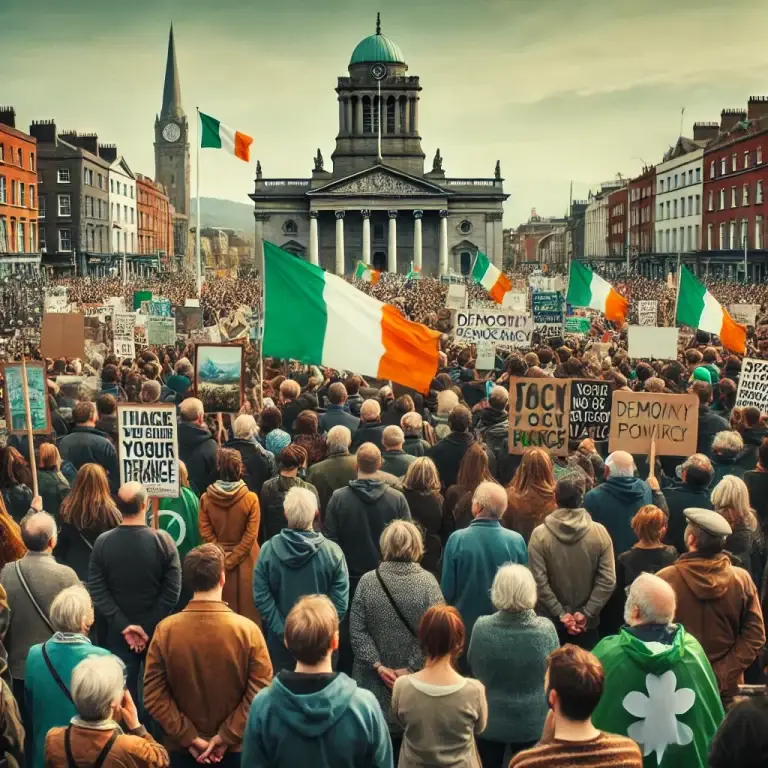

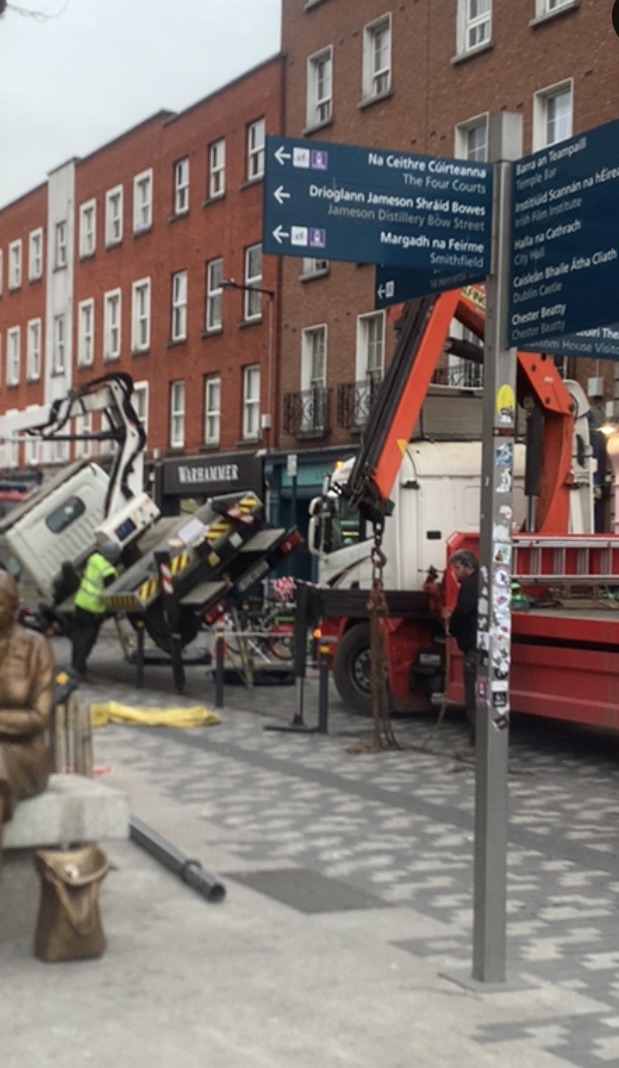

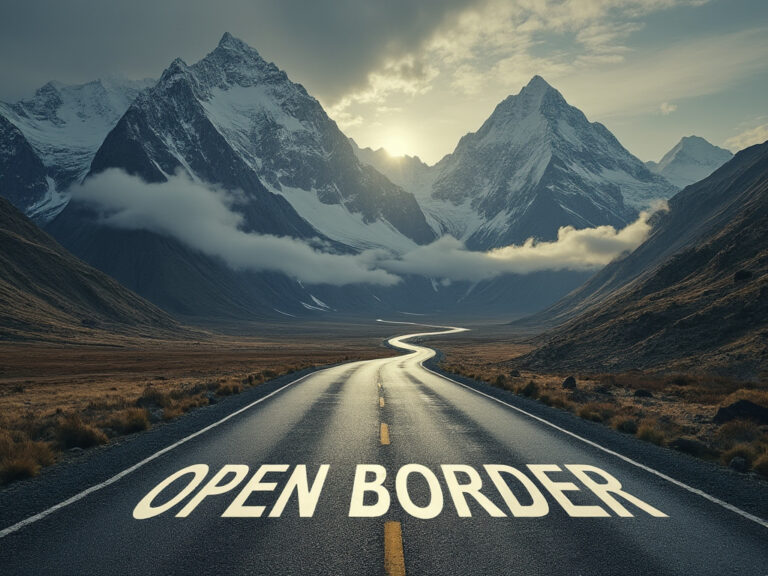
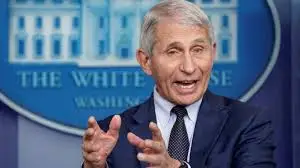
[…] the media bias in Irish election results mirrors these past tactics. When the media acts as a gatekeeper, it threatens the principles of […]